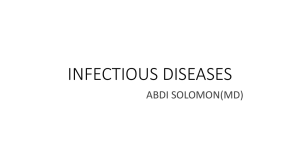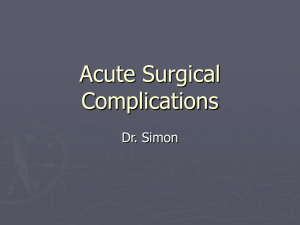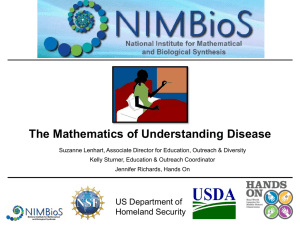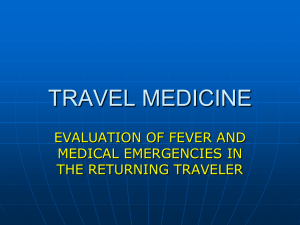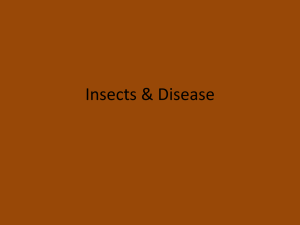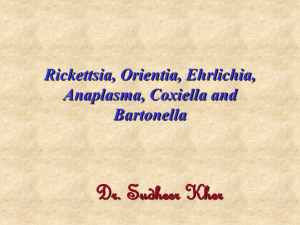Common tropical infection
advertisement
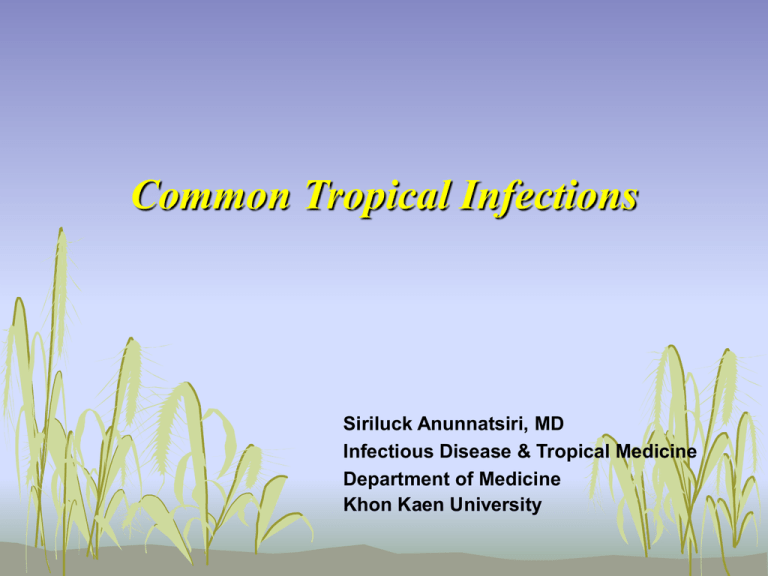
Common Tropical Infections Siriluck Anunnatsiri, MD Infectious Disease & Tropical Medicine Department of Medicine Khon Kaen University Tropical Infections: Definition Infectious diseases that either occur uniquely or more commonly in tropical and subtropical regions, are either more widespread in the tropics or more difficult to prevent or control. Tropical and Subtropical Regions 350 230 Common Tropical Infectious Diseases in Thailand • Leptospirosis • Rickettsioses: • Scrub typhus • Murine typhus • Melioidosis • Enteric fever • Typhoid fever • Paratyphoid fever • Nontyphoidal salmonellosis • Tuberculosis • Malaria • Dengue infection • Helminthic infection • Infective diarrhea Leptospirosis • The most widespread zoonosis in the world • Situation in Thailand สำนักระบำดวิทยำ กรมควบคุมโรค กระทรวงสำธำรณสุ ข Pathogenic Leptospira spp. 1% each 7.5% 88% 2.5% Lancet Infect Dis 2003; 3: 758 Saprophytic Leptospira species Species Serovar Reference strain Serogroup Genomospecies 3 holland Waz Holland Holland (P438) L. biflexa patoc Patoc I L. wolbachii codice CDC Semaranga Lancet Infect Dis 2003; 3: 758 Reservoir hosts of common leptospiral serovar Lancet Infect Dis 2003; 3: 758 Risk factors for exposure to leptospires • Occupational groups Farmers, ranchers, abattoir workers, trappers, veterinarians, loggers, sewer workers, rice-field workers, military personnel • Recreational activities Freshwater swimming, canoeing, kayaking, trail biking, hunting • Household environment Pet dogs, domesticated livestock, rainwater catchment systems, rodent infestation Pathogenesis Route of transmission: Abrasion & cuts in skin Mucous membrane/Conjunctiva Intact skin after prolong immersion in water Inhalation of aerosol/water Ingestion Toxin production: LPS Hemolysin Cytotoxin Outer envelope: Antiphagocytic component Outer membrane Immune complex mediated inflammation: protein: Interstitial nephritis Interstitial nephritis Vasculitis Clinical manifestations Anicteric leptospirosis Icteric leptospirosis Weil’s syndrome Leptospiremic phase 3-7 days Immune phase Leptospiremic phase 0-30 days 3-7 days Associated symptoms Myalgia Headache Nausea, Vomiting Abdominal pain Conjunctival suffusion Meningitis Uveitis Rash Leptospires present in Blood (Incubation period 2-20 days) Immune phase 0-30 days Fever Jaundice Hemorrhage Acute renal failure Myocarditis Hemorrhagic pneumonitis Meningoencephalitis Hypotension Blood CSF CSF Urine Urine Clinical manifestations Lancet Infect Dis 2003; 3: 758 Laboratory diagnosis • Culture • Antibody detection • Screening test MSAT, IHA, IFA, LA, ELISA, LEPTO dipstick • Confirmation test Microscopic agglutination test • Antigen detection • Polymerase chain reaction (PCR) • Pathology Treatment • Supportive & Symptomatic Treatment • Antimicrobial therapy Mild form • Doxycycline • Amoxicillin • Erythromycin Moderate-to-severe form • Penicillin G • Doxycycline • Ceftriaxone Prevention • Protective clothing, rodent control, preventing recreation exposure • Chemoprophylaxis • Doxycycline 200 mg once a week • Vaccine • Animal • Human – 2 developing vaccines but no license vaccine approval in human use Rickettsioses Scrub typhus • Orientia tsutsugamushi • Vector: Trombiculid mite (chigger): Leptothrombidium spp. Murine typhus • Rickettsia typhi • Vector: Xenopsylla cheopsis Spotted fever rickettsioses • R. helvetica, R. honei, R. felis, R. conorii • Vectors: Ticks www.eco-pestcontrol.com Distribution of scrub typhus in Asia Redrawn from Harwood and James (1979) Life cycle of murine typhus Pathogenesis of rickettsioses • Vector bites and feeds and regurgitate bacteria into skin bite site. • Bacteria are carried via lymphatics/small blood vessels to general circulation where they invade endothelial cells (primary target) • Spread via the microcirculation and invade all organ systems • Vasculitis resulting in local thrombus formation and end organ damage. • Spread to contiguous endothelial cells, smooth muscle cells, and phagocytes http://pathmicro.med.sc.edu/mayer/ricketsia.htm Clinical presentations • • • • • • • Fever Myalgia Headache Nausea/vomiting Abdominal pain Diarrhea Conjunctival suffusion / subconjunctival hemorrhage • • • • • • Lymphadenopathy Rash Hepatomegaly Splenomegaly Jaundice Altered consciousness • Seizure • Hypotension Clinical presentations Laboratory diagnosis • Culture • Antibody detection • Weil-Felix test: • OX-K for scrub typhus • OX-19 for murine typhus • Latex agglutination test, dot-blot ELISA • Confirmation tests: IFA, IIP • Polymerase chain reaction (PCR) • Pathology Treatment Scrub typhus • Doxycycline • Chloramphenicol • Rifampicin • Azithromycin Murine typhus • Doxycycline • Chloramphenicol Melioidosis • Burkholderia pseudomallei • Risk factors • • • • • Diabetes mellitus Thalassemia Preexisting renal diseases Chronic liver diseases Immunosuppressive use • Transmission • Direct inoculation • Inhalation • Ingestion, sexual contact (rare) Worldwide distribution of melioidosis Melioidosis: Clinical classification • Disseminated septicemic melioidosis • Non-disseminated septicemic melioidosis • Multifocal localized melioidosis • Localized melioidosis • Probable melioidosis • Subclinical melioidosis Clinical presentations of melioidosis % of patients in: Clinical presentations Royal Darwin Hospital; n=252 Infectious Diseases Association of Thailand; n=686 Srinagarind Hospital; n=100 Pneumonia 58 45 49 Bacteremia 46 57 59 Hepatosplenic abscess 6 9 52 Skin&soft tissue infection 17 16 23 Genitourinary tract infection 19 7 13 Bone&joint infection 4 5 27 Neurological melioidosis 4 3 NR Pericardial effusion 1 3 NR Clinical presentations Lancet 2003; 361: 1720 Laboratory diagnosis • Culture – Gold standard • Antibody detection • IHA,ELISA, immunochromatographic test, dot immunoassay, Gold-blot immunoassay • Antigen detection • ELISA, latex agglutination, IFA • Polymerase chain reaction Treatment • Acute phase • Ceftazidime + cotrimoxazole • Cefoperazone/sulbactam + co-trimoxazole • Imipenem/Meropenem • Co-amoxiclav At least 10-14 days • Maintenance phase • Co-trimoxazole + doxycycline • Co-amoxiclav • Ciprofloxacin + azithromycin At least 20 weeks Enteric fever • Typhoid fever Salmonella Typhi • Paratyphoid fever Salmonella Paratyphi A, B, and C สำนักระบำดวิทยำ กรมควบคุมโรค กระทรวงสำธำรณสุ ข Pathogenesis www.netterimages.com Symptoms of enteric fever Symptoms Fever Headache Nausea Vomiting Abdominal cramp Diarrhea Constipation Cough Typhoid fever (%) 89-100 43-90 23-36 24-35 8-52 Paratyphoid fever (%) 92-100 60-100 33-58 22-45 29-92 30-57 10-79 11-36 17-68 2-29 10-68 Signs of enteric fever Symptoms Typhoid fever (%) Paratyphoid fever (%) Abdominal tenderness 33-84 6-29 Splenomegaly 23-65 0-74 Hepatomegaly 15-52 16-32 Relative bradycardia 17-50 11-100 Rose spots 2-46 0-3 Rales & rhonchi 8-84 2-87 Epitaxis 1-21 2-13 Meningism 1-12 0-3 Laboratory diagnosis • Culture – Gold standard: Blood, BM, duodenal string test • Antibody detection • Widal test – poor sensitivity & specificity • Rapid serological diagnostic test Lancet 2005; 366: 754 Drug resistance S. Typhi 1990-2004 Lancet 2005; 366: 752 Treatment Lancet 2005; 366: 755 Prevention • Safe water & food, personal hygiene, appropriate sanitation • Vaccination Vi polysaccharide vaccine, Ty21a vaccine, Vi conjugate vaccine Lancet 2005; 366: 757 Malaria • 4 human Plasmodium sp. pathogens P. falciparum P. vivax P. ovale P. malariae • Vector: Anopheles sp. สำนักระบำดวิทยำ กรมควบคุมโรค กระทรวงสำธำรณสุ ข Malaria: Life Cycle http://www.cdc.gov Clinical outcome of malarial infection Nature 2002; 415: 673-679. Pathogenesis of P. falciparum Nature 2002; 415: 673-679. Uncomplicated malaria Signs and symptoms of malaria: non-specific • • • • • • • • Fever Chills Headache Myalgia Sore throat Anorexia Anemia Hepatosplenomegaly WHO criteria for severe malaria • • • • • • • • • • • • Cerebral malaria Impaired of consciousness (GCS <11) Severe anemia (Hct <20% or Hb <7 g/dl) Hypoglycemia (BS <40 mg/dl) Metabolic acidosis (HCO3 <15 mmol/L) Acute renal failure (Cr >3 mg/dl and urine output <400 ml/day) Acute pulmonary edema and ARDS Shock Abnormal bleeding Jaundice (TB >2.5 mg/dl) Hemoglobinuria Hyperparasitemia ( infection rate >5%) WHO. Trans R Soc Trop Med Hyg 2000; 94 (Suppl). Laboratory diagnosis • Thick and thin film blood smear – Gold standard • Antigen detection by rapid dipstick immunochromatographic assays • Histidine-rich protein-2: P. falciparum • Parasite-specific LDH: All Plasmodium spp. • PCR technique Plasmodium falciparum Plasmodium vivax Plasmodium malariae Plasmodium ovale Antimalarial treatment: Uncomplicated falciparum malaria or mixed infection Drugs Doses Duration (days) Artemether (20) – lumefantrine (120) <15 kg: 1 tab BID 16-25 kg: 2 tabs BID 26-35 kg: 3 tabs BID >35 kg: 4 tabs BID 3 Atovaquone (250) – proguanil (100) 20 mg/kg/day 8 mg/kg/day 3 Quinine SO4 + Tetracycline or Doxycycline Clindamycin 10 mg/kg TID 7 Artesunate + Mefloquine 4 mg/kg/day 4 mg/kg QID 2 mg/kg BID 5 mg/kg TID 15 mg/kg 10 mg/kg 3 2nd day of Rx 3rd day of Rx Antimalarial treatment: Severe malaria or Uncomplicated malaria with parasitemia >4% IRBC Artesunate i.v. 2.4 mg/kg at hour 0 and 12 followed by 2.4 mg/kg daily until oral medication is tolerated. Continue oral drug 2 mg/kg daily until day 7, adding 2nd agent as for quinine (below) Quinine HCl i.v. 20 mg/kg given over 4 hours, then 10 mg/kg every 8 hours. A second drug, e.g. doxycycline, tetramycin, or clindamycin for 7 days; or atovaquone + proguanil for 3 days, should be added when the patient can tolerate oral medication. Antimalarial treatment: Non-falciparum malaria Chloroquine 600 mg base at hour 0 followed by 300 mg base at hour 6, 2nd day, and 3rd day of treatment + Primaquine (for P. vivax and P. ovale only) 0.3-0.6 mg base/kg daily for 14 days Prevention • Vector control • Insecticide spraying • Larva control • Personal protection • Insecticide-treated bednets • Insect repellents • Wearing appropriate clothing • Antimalarial chemoprophylaxis • “Stand-by” emergency treatment


